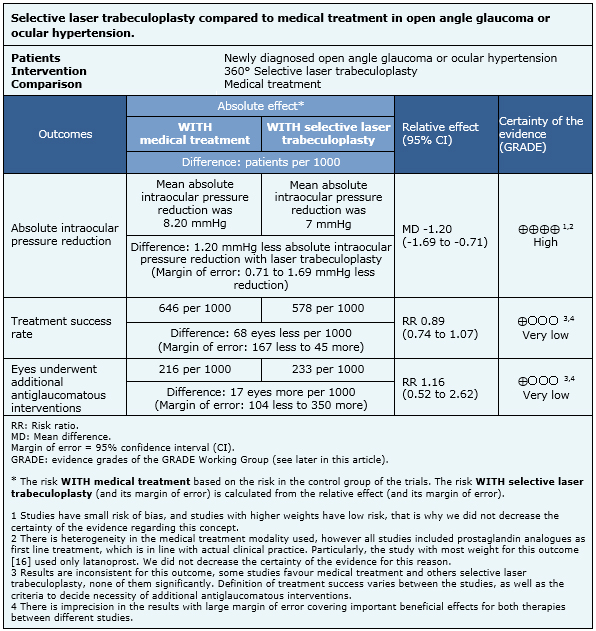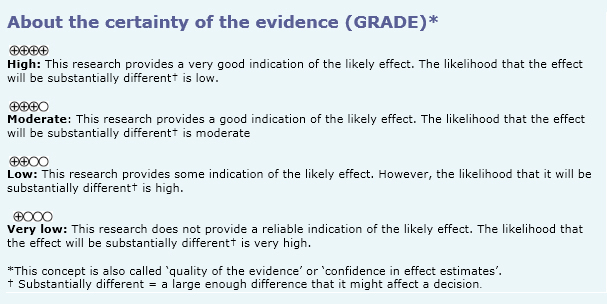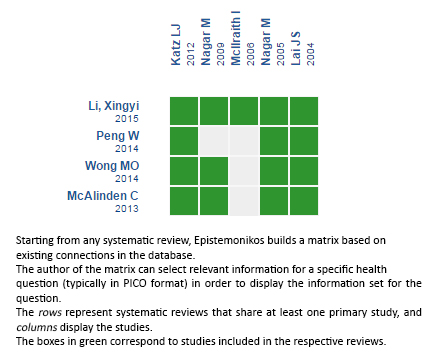Resúmenes Epistemonikos
← vista completaPublicado el 17 de diciembre de 2015 | http://doi.org/10.5867/medwave.2015.6337
¿Es mejor la trabeculoplastía láser selectiva o el tratamiento médico para el glaucoma de ángulo abierto o hipertensión ocular de diagnóstico reciente?
Selective laser trabeculoplasty compared with medical treatment for the initial management of open angle glaucoma or ocular hypertension
Abstract
Selective laser trabeculoplasty is a relatively new therapeutic alternative for the management of open angle glaucoma and ocular hypertension. On the other hand, medical treatment has robust data supporting its efficacy and has progressed in last decades with the introduction of prostaglandin analogues. To compare these two therapies, we searched Epistemonikos database, which is maintained by screening 30 databases, and identified four systematic reviews including four randomized and one non-randomized clinical trial. We combined the evidence using meta-analysis and generated a summary of findings table following the GRADE approach. We concluded that selective laser trabeculoplasty leads to a smaller absolute intraocular pressure reduction than medical treatment. However, it is not clear if there are differences in treatment success rate or need of additional antiglaucomatous interventions, because the quality of the evidence is low.
Problem
Open angle glaucoma and ocular hypertension are initially asymptomatic conditions that frequently course with additional optic nerve damage that may lead to progressive loss of visual field and irreversible blindness at an end stage if they are not treated appropriately. In clinical practice medical treatment is usually preferred as first line therapy, but laser trabeculoplasty or surgery are also valid options in selected patients as suggested by The American Academy of Ophthalmology [1].
Laser trabeculoplasty was first introduced in 1979, using argon laser [2]. A decade later, the procedure demonstrated to be as effective as timolol for intraocular pressure reduction in the initial management of open angle glaucoma or ocular hypertension [3]. Few years later prostaglandin analogues were introduced and demonstrated to produce greater intraocular pressure reduction than timolol [4], with the advantage of requiring only once daily dosing. However, adherence to medical treatment remains an important problem as shown by recent reports of 25% of missed doses even when patients knew they were being monitored [5].
In this context, selective laser trabeculoplasty [6] could offer many theoretical advantages over argon laser trabeculoplasty such as easier application, and lower energy parameters that could reduce coagulative damage in trabecular meshwork. The latter has used as an argument to justify that the procedure can be repeated while the recommendation for argon laser trabeculoplasty is against repeatability. There is evidence that the effectiveness of both interventions is similar [7], and despite only weak evidence of repeatability for selective laser trabeculoplasty [8], it is being used in clinical practice as a repeatable procedure without reports of intraocular pressure decompensation as previously seen with argon laser trabeculoplasty [9],[10].
Taking into account the introduction of new and better medications as well as selective laser trabeculoplasty a procedure that is easier to apply and potentially repeatable, we consider this effectiveness comparison of selective laser trabeculoplasty vs medical treatment for intraocular pressure reduction in open-angle glaucoma or ocular hypertension of great interest.
Methods
We used Epistemonikos database, which is maintained by screening more than 30 databases, to identify systematic reviews and their included primary studies. With this information, we generated a structured summary using a pre-established format, which includes key messages, a summary of the body of evidence (presented as an evidence matrix in Epistemonikos), meta-analysis of the total of studies, a summary of findings table following the GRADE approach and a table of other considerations for decision-making.
|
Key messages
|
About the body of evidence for this question
|
What is the evidence. |
We found four systematic reviews [7],[11],[12],[13] that include four randomized clinical trials [14],[15],[16],[17] and one non randomized prospective study [18]. In this table and the summary in general, we only considered the randomized trials. Three of the four systematic reviews did a meta-analysis [7],[11],[19]. |
|
What types of patients were included |
All of the randomized clinical trials included patients with ocular hypertension or primary open angle glaucoma. Two of them included also patients with secondary open angle glaucoma, particularly pseudoexfoliation glaucoma [14],[17] and pigment dispersion syndrome [17]. Only one study included patients with mixed mechanism open angle glaucoma with a narrow angle, if laser peripheral iridotomy was performed more than three months ago, but this study did not report the number of patients included with this diagnosis [14]. All the studies included newly or recently diagnosed patients. Two of them also included patients previously controlled with medical treatment [14],[17]. There is no distinction by sex. Only two studies restricted age as inclusion criteria: one of them considered only patients under the age of 80 [16]; the other included patients between 25 and 82 years [14]. All the studies excluded patients with previous laser procedure or ocular surgery disturbing the aqueous outflow. Three of the randomized clinical trials considered pregnancy as exclusion criteria [14],[15],[16]. Studies included patients that belong to multiple ethnic groups: Chinese population [15], African or afro-Caribbean [17], white [14],[17] or non-white [14]. Only one study established an upper limit of intraocular pressure, including patients with pressures between 24 and 34 mmHg in the higher eye, and 20 mmHg or more in the contralateral eye [14]. |
|
What types of interventions were included |
All the studies compared selective laser trabeculoplasty with medical treatment. Regarding laser trabeculoplasty, all randomized clinical trials used similar procedures, with energy ranging from 0,2 to 1,7 mJ per application, adjusted according to patients characteristics and response, and applied over 360 degrees (approximately 100 non-overlapping laser spots). Regarding the extent of trabecular meshwork treated, one study [17] randomized patients into four groups, one receiving medical treatment, and other three groups treated with selective laser trabeculoplasty in different extent of trabecular meshwork: 360º, 180º and 90º respectively. This differs from the other three randomized clinical trials [14],[15],[16], which applied selective laser trabeculoplasty over 360º of trabecular meshwork. Only treatments performed over 360 degrees were considered for this summary. Medical treatment modality varied across studies. Two of the randomized clinical trials [16],[17] used exclusively latanoprost, a prostaglandin analogue. One study used [15] a variable combination of medicines including latanoprost, beta-blocker, pilocarpine and dorzolamide. The other randomized clinical trial [14] applied a flexible algorithm of treatment with sequential steps starting with prostaglandin analogues, then adding or substituting to beta-blocker, then brimonidine, and finally dorzolamide, brinzolamide or a fixed-combination dorzolamide-timolol. Follow up also varied across studies: one of them [15] followed patients for five years; two studies [14],[17] did for one year; and other study [16] for four to six months. |
|
What types of outcomes |
The systematic reviews included here, analysed the following outcomes: absolute intraocular pressure reduction [7],[19], treatment success rate [7],[19] and need of additional antiglaucomatous interventions [19]. There is heterogeneity in treatment success definition: one primary study [16] defined it as achieving an intraocular pressure reduction of 20% or more; other study [17] used two definitions, considering intraocular pressure reduction of 20% and 30% from baseline; one study [14] defined treatment success when achieving a target intraocular pressure reduction calculated by using a formula; other [15] defined it indirectly considering treatment failure when intraocular pressure was greater than 21 mmHg in follow up. Different adverse effects were evaluated by three of the randomized clinical trials [14],[15],[17]: ocular pain or discomfort [17], anterior chamber reaction [15], peripheral anterior synechiae [14], uveitis [14],[17], post-laser intraocular pressure spike [15],[17] and increase in trabecular meshwork pigmentation [15]. |
Summary of findings
This information is based on four randomized clinical trials including 271 eyes of 201 patients. All studies measured absolute intraocular pressure reduction and treatment success rate. Three of them [14],[15],[17] evaluated the need of additional antiglaucomatous interventions. The summary of finding is the following:
- Selective laser trabeculoplasty results in less intraocular pressure reduction than medical treatment in patients with open angle glaucoma or ocular hypertension. The certainty of evidence is high.
- It is not clear if there are differences in treatment success rate because the certainty of the evidence is very low for this outcome.
- It is not clear if there are differences in need of additional antiglaucomatous interventions, because the certainty of the evidence is very low.
- There is no report of relevant adverse effects for the studied treatment modalities.


Other considerations for decision-making
|
To whom this evidence does and does not apply |
|
| About the outcomes included in this summary |
|
| Balance between benefits and risks, and certainty of the evidence |
|
| Resource considerations |
|
|
Differences between this summary and other sources |
|
| Could this evidence change in the future? |
|
How we conducted this summary
Using automated and collaborative means, we compiled all the relevant evidence for the question of interest and we present it as a matrix of evidence.

Follow the link to access the interactive version: Selective laser trabeculoplasty versus medical treatment for open angle glaucoma and ocular hypertension
Notes
The upper portion of the matrix of evidence will display a warning of “new evidence” if new systematic reviews are published after the publication of this summary. Even though the project considers the periodical update of these summaries, users are invited to comment in Medwave or to contact the authors through email if they find new evidence and the summary should be updated earlier. After creating an account in Epistemonikos, users will be able to save the matrixes and to receive automated notifications any time new evidence potentially relevant for the question appears.
The details about the methods used to produce these summaries are described here http://dx.doi.org/10.5867/medwave.2014.06.5997.
Epistemonikos foundation is a non-for-profit organization aiming to bring information closer to health decision-makers with technology. Its main development is Epistemonikos database (www.epistemonikos.org).
These summaries follow a rigorous process of internal peer review.
Conflicts of interest
The authors do not have relevant interests to declare.

